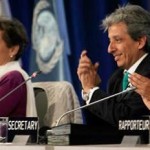
Doha – At the UN Climate Change Conference in Doha, Qatar (COP18/CMP8), governments have taken the next essential step in the global response to climate change.
Countries have successfully launched a new commitment period under the Kyoto Protocol, agreed a firm timetable to adopt a universal climate agreement by 2015 and agreed a path to raise necessary ambition to respond to climate change. They also endorsed the completion of new institutions and agreed ways and means to deliver scaled-up climate finance and technology to developing countries.
“Doha has opened up a new gateway to bigger ambition and to greater action – the Doha Climate Gateway. Qatar is proud to have been able to bring governments here to achieve this historic task. I thank all governments and ministers for their work to achieve this success. Now governments must move quickly through the Doha Climate Gateway to push forward with the solutions to climate change,” said COP President Abdullah bin Hamad Al-Attiyah.
The Executive Secretary of the UN Framework Convention on Climate Change (UNFCCC), Christiana Figueres, called on countries to swiftly implement what has been agreed in Doha so that the world can stay below the internationally agreed maximum two degrees Celsius temperature rise.
“I congratulate the Qatar Presidency for managing a complex and challenging conference. Now, there is much work to do. Doha is another step in the right direction, but we still have a long road ahead. The door to stay below two degrees remains barely open. The science shows it, the data proves it,” said Ms. Figueres.
“The UN Climate Change negotiations must now focus on the concrete ways and means to accelerate action and ambition. The world has the money and technology to stay below two degrees. After Doha, it is a matter of scale, speed, determination and sticking to the timetable,” she said.
In Doha, governments also successfully concluded work under the Convention that began in Bali in 2007 and ensured that remaining elements of this work will be continued under the UN Climate Change process.
The next major UN Climate Change Conference – COP19/CMP9 – will take place in Warsaw, Poland, at the end of 2013.
Results of COP18/CMP8
1) Amendment of the Kyoto Protocol
The Kyoto Protocol, as the only existing and binding agreement under which developed countries commit to cutting greenhouse gases, has been amended so that it will continue as of 1 January 2013.
- Governments have decided that the length of the second commitment period will be 8 years.
- The legal requirements that will allow a smooth continuation of the Protocol have been agreed.
- The valuable accounting rules of the protocol have been preserved.
- Countries that are taking on further commitments under the Kyoto Protocol have agreed to review their emission reduction commitments at the latest by 2014, with a view to increasing their respective levels of ambition.
- The Kyoto Protocol’s Market Mechanisms – the Clean Development Mechanism (CDM), Joint Implementation (JI) and International Emissions Trading (IET) – can continue as of 2013.
- Access to the mechanisms will be uninterrupted for all developed countries that have accepted targets for the second commitment period.
- JI will continue to operate, with the agreed technical rules allowing the issuance of credits, once a host country’s emissions target has been formally established.
- Australia, the EU, Japan, Lichtenstein, Monaco and Switzerland have declared that they will not carry over any surplus emissions trading credits (Assigned Amounts) into the second commitment period of the Kyoto Protocol.
2) Time Table for the 2015 Global Climate Change Agreement and Increasing Ambition Before 2020
Governments have agreed to speedily work toward a universal climate change agreement covering all countries from 2020, to be adopted by 2015, and to find ways to scale up efforts before 2020 beyond the existing pledges to curb emissions so that the world can stay below the agreed maximum 2 degrees Celsius temperature rise.
- A significant number of meetings and workshops are to be held in 2013 to prepare the new agreement and to explore further ways to raise ambition.
- Governments have agreed to submit to the UN Climate Change Secretariat, by 1 March 2013, information, views and proposals on actions, initiatives and options to enhance ambition.
- Elements of a negotiating text are to be available no later than the end of 2014, so that a draft negotiating text is available before May 2015.
- In Doha, the UN Secretary General Ban Ki-moon announced he would convene world leaders in 2014 to mobilize the political will to help ensure the 2015 deadline is met.
3) Completion of New Infrastructure
In Doha, governments significantly advanced the completion of new infrastructure to channel technology and finance to developing nations and move toward the full implementation of this infrastructure and support. Most importantly, they have:
- Endorsed the selection of the Republic of Korea as the location of the Green Climate Fund and the work plan of the Standing Committee on Finance. The Green Climate Fund is expected to start its work in Sondgo in the second half of 2013, which means that it can launch activities in 2014.
- Confirmed a UNEP-led consortium as host of the Climate Technology Center (CTC), for an initial term of five years. The CTC, along with its associated Network, is the implementing arm of the UNFCCCs Technology Mechanism. Governments have also agreed the constitution of the CTC advisory board.
4) Long-Term Climate Finance
- Developed countries have reiterated their commitment to deliver on promises to continue long-term climate finance support to developing nations, with a view to mobilizing 100 billion USD both for adaptation and mitigation by 2020.














